Highlights from 2006:
5/29/2006 - Successful Memorial Day Commemoration
Ceremony at Arlington National Cemetery. About 40 members and
guests which included representatives from NATO, both the US and Hungarian
military,  Hungarian
American leaders, and representatives from the Hungarian Embassy witnessed
the Memorial Day ceremony. Arlington National is the final resting place
for a number of Hungarian American Congressional Hungarian
American leaders, and representatives from the Hungarian Embassy witnessed
the Memorial Day ceremony. Arlington National is the final resting place
for a number of Hungarian American Congressional 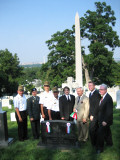 Medal
of Honor recipients. Following the program that included a roll call in
honor of those in present and past military service and a presentation
on Hungarian and American military traditions, the group proceeded on
a walking tour of 8 additional Hungarian American gravesites scattered
throughout the sprawling grounds. Details about those brave men can be
seen to the right. Medal
of Honor recipients. Following the program that included a roll call in
honor of those in present and past military service and a presentation
on Hungarian and American military traditions, the group proceeded on
a walking tour of 8 additional Hungarian American gravesites scattered
throughout the sprawling grounds. Details about those brave men can be
seen to the right.
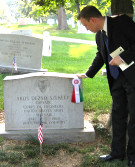 Bryan
Dawson-Szilagyi, AHF Executive Committee Chair (seen here placing the
AHF commemorative ribbon on the grave of Capt. Akos Szekely who died a
hero's death in Vietnam), wrote, "Most special to me was that our
commemoration had such a unique historical perspective... A perspective
that gave us a deeper understanding of the noble depths of the Hungarian
military tradition - a tradition that so many families carried on and
one we must honor by remembrance...[With the descendants of Gens. Asboth
and Kozlay there with us] We literally touched history - a history across
generations, centuries, and continents. A few highlights: Bryan
Dawson-Szilagyi, AHF Executive Committee Chair (seen here placing the
AHF commemorative ribbon on the grave of Capt. Akos Szekely who died a
hero's death in Vietnam), wrote, "Most special to me was that our
commemoration had such a unique historical perspective... A perspective
that gave us a deeper understanding of the noble depths of the Hungarian
military tradition - a tradition that so many families carried on and
one we must honor by remembrance...[With the descendants of Gens. Asboth
and Kozlay there with us] We literally touched history - a history across
generations, centuries, and continents. A few highlights:
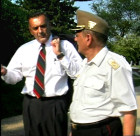 The
descendants of Gen. Kozlay met with the descendant of Gen. Asboth for
the first time (Gusztav Asboth is seen here on the left with Hungarian
Military Attache Janos Varga). We learned that Gen. Eugene Kozlay served
under Lajos Asboth, Sandor's older brother, in the 1848-49 war. Eugene
Kozlay also knew Sandor in New York, and he is mentioned several times
in Eugene's diary in the 1848 revolution. Hungary recognized the Kozlays
with the Pro Cultura Hungarica award after they donated Gen Kozlay's manuscripts
to the Petöfi Literary Museum in Budapest. We witnessed these great
Hungarian families shake hands in 2006. A number of those present at Gen.
Asboth's re-internment returned to commemorate his contributions once
again. The
descendants of Gen. Kozlay met with the descendant of Gen. Asboth for
the first time (Gusztav Asboth is seen here on the left with Hungarian
Military Attache Janos Varga). We learned that Gen. Eugene Kozlay served
under Lajos Asboth, Sandor's older brother, in the 1848-49 war. Eugene
Kozlay also knew Sandor in New York, and he is mentioned several times
in Eugene's diary in the 1848 revolution. Hungary recognized the Kozlays
with the Pro Cultura Hungarica award after they donated Gen Kozlay's manuscripts
to the Petöfi Literary Museum in Budapest. We witnessed these great
Hungarian families shake hands in 2006. A number of those present at Gen.
Asboth's re-internment returned to commemorate his contributions once
again.
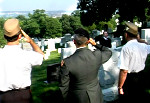 We
met Shirley Olchvary whose husband, Col. Paul Olchvary, served with distinction
in the US Army (his father, Col. Istvan Olchvary served in the Hungarian
Chief-of-Staff's Office and graduated from the famed Ludovika Military
Academy as did another AHF member - Gabor Olah). It was interesting to
hear how Col. Olchvary and Lt. Col. Vekony both joined military service
"to give back" what America had given to their parents. We
met Shirley Olchvary whose husband, Col. Paul Olchvary, served with distinction
in the US Army (his father, Col. Istvan Olchvary served in the Hungarian
Chief-of-Staff's Office and graduated from the famed Ludovika Military
Academy as did another AHF member - Gabor Olah). It was interesting to
hear how Col. Olchvary and Lt. Col. Vekony both joined military service
"to give back" what America had given to their parents. 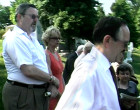 A
sentiment that rings true to me and so many Hungarian Americans of that
generation. A
sentiment that rings true to me and so many Hungarian Americans of that
generation.
We learned that a nephew of the Lendvais (Imre is seen here to the left
of AHF Chairman of the Board Akos Nagy) is head of the International Hungarian
Boyscouts) is currently serving in Iraq.
 We
met the son of Francis Gary Powers the US national hero who risked his
life and was shot down in his high-altitude spyplane over the red skies
of the Soviet Union. Francis Jr. (seen here to the left of Janet and Doug
Kozlay, Pro Cultura Hungarica plaque recipients) carries on the fight
to make sure the world remembers his father and Soviet tyranny as Founder
and President of the Cold War Museum. We
met the son of Francis Gary Powers the US national hero who risked his
life and was shot down in his high-altitude spyplane over the red skies
of the Soviet Union. Francis Jr. (seen here to the left of Janet and Doug
Kozlay, Pro Cultura Hungarica plaque recipients) carries on the fight
to make sure the world remembers his father and Soviet tyranny as Founder
and President of the Cold War Museum.
 We
heard 1956 Freedom Fighter and former US Army officer Zoltan Bagdy and
Dr. Imre Toth, a former lieutenant in the Hungarian Army and the last
surviving Secretary of the Revolutionary Committee for the Ministry of
Foreign Affairs for the Imre Nagy Government in 1956, call out the names
of so many of our brothers who served the cause of freedom. We
heard 1956 Freedom Fighter and former US Army officer Zoltan Bagdy and
Dr. Imre Toth, a former lieutenant in the Hungarian Army and the last
surviving Secretary of the Revolutionary Committee for the Ministry of
Foreign Affairs for the Imre Nagy Government in 1956, call out the names
of so many of our brothers who served the cause of freedom.
We received recommendations for the roll call from far and wide, including
the President of the 25th Infantry Regiment Association, the regiment
of Silver Star hero Akos Szekely. Others included Paul de Holczer and
Joe Ivany who lost his son in Iraq.
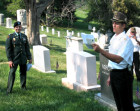 In
this year, the 50th anniversary year of the 1956 Hungarian Revolution,
it was particularly poignant to see freedom fighters share this day with
American and Hungarian military officials that included the Military Attaches
to the United States (Col. Varga and Maj. Bone) and Hungary's NATO representative
(Col. Juhasz). Congratulations are in order for Lt. Col Vekony and Maj.
Bone for an excellent exchange and presentation. In
this year, the 50th anniversary year of the 1956 Hungarian Revolution,
it was particularly poignant to see freedom fighters share this day with
American and Hungarian military officials that included the Military Attaches
to the United States (Col. Varga and Maj. Bone) and Hungary's NATO representative
(Col. Juhasz). Congratulations are in order for Lt. Col Vekony and Maj.
Bone for an excellent exchange and presentation.
Finally, we touched the stones that serve as reminders of the heroes
buried there... heroes that fought in American battles that spanned 3
centuries. These men are not forgotten. What an example Bela Kovach, an
AHF member from Ohio, who travels to Hungary to kiss the grave of Alexander
Asboth's parents each year, in keeping with Asboth's last wishes. No,
Gen. Asboth, your parents are also not forgotten.
May the unity we found yesterday continue and permeate all things we
do."
[Click
here for additional images from 2006]
"Fidelissimus
ad Mortem" "Faithful unto Death"
 The
American Hungarian Federation (AHF) established the Colonel Commandant
Michael Kovats Medal of Freedom to honor outstanding individuals and recognize
their life's achievements, dedication to freedom and democracy, promotion
of transatlantic relations, and meritorious contribution to society. The
award, AHF's highest honor, is open to Hungarians and non-Hungarians alike. The
American Hungarian Federation (AHF) established the Colonel Commandant
Michael Kovats Medal of Freedom to honor outstanding individuals and recognize
their life's achievements, dedication to freedom and democracy, promotion
of transatlantic relations, and meritorious contribution to society. The
award, AHF's highest honor, is open to Hungarians and non-Hungarians alike.
Inscribed on the medal is AHF's Motto, “Fidelissimus ad Mortem"
or "Faithful Unto Death,” which represents Hungarian American
historical committment to the United States. The motto was taken from
a letter written by former Hussar Officer Michael Kováts to Benjamin
Franklin. Kovats, known as a Founding Father of the US Cavalry, offered
his sword in service to the United States. 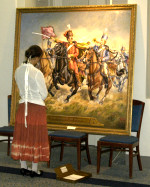 On
May 11, 1779, Colonel Kovats gave his life in the American War for Independence
while leading the Continental Army cavalry he had trained in Hungarian
hussar tactics against a British siege of Charleston. The British remarked
that Kovats' forces were "the best cavalry the rebels ever had."
He is immortalized in the almost lifesize portrait by Gabriella Koszrous-Varsa
seen here. He is immortalized at the Citadel Miltary Academy in South
Carolina as they honor him and named "Kovats Field" after him.
The Hungarian Embassy, too, has a statue in his honor sculpted by Paul
Takacs and executed by Attila Dienes. On
May 11, 1779, Colonel Kovats gave his life in the American War for Independence
while leading the Continental Army cavalry he had trained in Hungarian
hussar tactics against a British siege of Charleston. The British remarked
that Kovats' forces were "the best cavalry the rebels ever had."
He is immortalized in the almost lifesize portrait by Gabriella Koszrous-Varsa
seen here. He is immortalized at the Citadel Miltary Academy in South
Carolina as they honor him and named "Kovats Field" after him.
The Hungarian Embassy, too, has a statue in his honor sculpted by Paul
Takacs and executed by Attila Dienes.
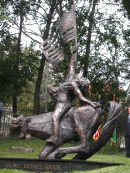 Just
as Kovats’ life and service is celebrated annually by US Military
Cadets at the Citadel, the motto reflects AHF virtues, and historically
and inextricably ties Hungarians and Americans together while symbolizing
Hungarians’ contributions and sacrifices to America’s beginning.
Among the oldest ethnic organizations in the US, AHF was founded in 1906
in Cleveland, Ohio, and established as an association of Hungarian societies,
institutions and churches to “defend the interest of Americans of
Hungarian origin in the United States.” Just
as Kovats’ life and service is celebrated annually by US Military
Cadets at the Citadel, the motto reflects AHF virtues, and historically
and inextricably ties Hungarians and Americans together while symbolizing
Hungarians’ contributions and sacrifices to America’s beginning.
Among the oldest ethnic organizations in the US, AHF was founded in 1906
in Cleveland, Ohio, and established as an association of Hungarian societies,
institutions and churches to “defend the interest of Americans of
Hungarian origin in the United States.”
See [Kovats
Medal Recipients]
 Sign
up for the AHF mailing list. Sign
up for the AHF mailing list.
Your information is not shared!
Join online
PRIVACY NOTICE: AHF will
not share its mailing list with anyone...Period. AHF also uses this list
SPARINGLY.
DISCLAIMER: The American
Hungarian Federation does not necessarily endorse the content or opinions
found in the external sites found this eNewsletter or those expressed
by its individual members and member organizations...
© 2007 American Hungarian Federation,
All Rights Reserved
[ >
GO to all AHF news]
|
Hungarian Americans
in Arlington Cemetery
[Download
the May 29, 2006 program] or see below to learn more about the Hungarian
Americans buried at Arlington National Cemetery. IF YOU KNOW additional
Hungarian Americans buried in Arlington National, please contact
us!
General Alexander
Asbóth
(b. 1811, Hungary, d. 1868, Argentina)
Military Chief-of-Staff, US Minister
 Asbóth was a General in the Hungarian Army. Following the Hungarian
democratic Revolt of 1848 against Austria, he followed Kossuth to the
United States in 1851. He offered his services to the Union when the Civil
War broke out. John C. Fremont appointed him a Brigadier General of Volunteers
and chief-of-staff. Seriously wounded three times during the war, he was
appointed to the rank of general in l864.
Asbóth was a General in the Hungarian Army. Following the Hungarian
democratic Revolt of 1848 against Austria, he followed Kossuth to the
United States in 1851. He offered his services to the Union when the Civil
War broke out. John C. Fremont appointed him a Brigadier General of Volunteers
and chief-of-staff. Seriously wounded three times during the war, he was
appointed to the rank of general in l864.
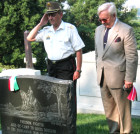 At
the Battle of Pea Ridge, Arkansas, he was wounded in the left arm. Despite
the wound, he saddled up next morning. His arm was later shattered and
a bullet lodged under his cheek in the Marianna engagement in Florida.
In 1866, he was appointed U.S. Minister to Argentina and Uruguay. At
the Battle of Pea Ridge, Arkansas, he was wounded in the left arm. Despite
the wound, he saddled up next morning. His arm was later shattered and
a bullet lodged under his cheek in the Marianna engagement in Florida.
In 1866, he was appointed U.S. Minister to Argentina and Uruguay. 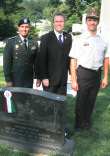 The
wound in his cheek failed to heal, and on January 21, 1868, he died and
was buried in Buenos Aires, Argentina. He finally came home on October
23, 1990 to full military honors at Arlington National Cemetery thanks
to the Hungarian Freedom Fighters’ Federation. His grandson attended
the funeral and is in the Virginia National Guard. Read more about him
on Arlington
Cemetery.net. The
wound in his cheek failed to heal, and on January 21, 1868, he died and
was buried in Buenos Aires, Argentina. He finally came home on October
23, 1990 to full military honors at Arlington National Cemetery thanks
to the Hungarian Freedom Fighters’ Federation. His grandson attended
the funeral and is in the Virginia National Guard. Read more about him
on Arlington
Cemetery.net.
BURIED AT: SECTION 2
Major-General Julius
H. Stáhel
(b. 1825, Hungary d. 1912, NY)
Congressional Medal of Honor
 Hussar in the 1848 war of independence. Escaped with Kossuth to the United
States. Worked as a Journalist. At the outbreak of the Civil War, organized
the 8th New York Volunteer Infantry becoming lieutenant-colonel. At the
Hussar in the 1848 war of independence. Escaped with Kossuth to the United
States. Worked as a Journalist. At the outbreak of the Civil War, organized
the 8th New York Volunteer Infantry becoming lieutenant-colonel. At the
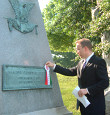 First
Battle of Bull Run, 1861, he prevented Confederate forces from advancing
on Washington. President Lincoln personally expressed his appreciation.
Promoted to Colonel and shortly afterwards, received his star as a brigadier
general. After Mosby's raid at First
Battle of Bull Run, 1861, he prevented Confederate forces from advancing
on Washington. President Lincoln personally expressed his appreciation.
Promoted to Colonel and shortly afterwards, received his star as a brigadier
general. After Mosby's raid at  Fairfax
Court House, Lincoln summoned Stahel and ordered him to take charge of
the cavalry at Fairfax and raised him to the rank of major general. Fairfax
Court House, Lincoln summoned Stahel and ordered him to take charge of
the cavalry at Fairfax and raised him to the rank of major general.
Stahel received the US Congressional Medal of Honor for
his bravery at the Battle of Piedmont in Virginia. While wounded, the
General led a cavalry charge which led to a Union victory. In 1866 President
Andrew Johnson appointed Stahel consul in Japan where he succeeded in
opening additional ports to American trade. In 1884 he was made consul
in Shanghai, China.
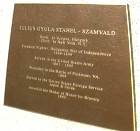 BURIED
AT: SECTION 2 BURIED
AT: SECTION 2
Read more on Arlington
Cemetery.net
or download Prof.
Stephen Beszedits' essay on Gen. Stahel for the Military Order of
the Loyal Legion of the United States
S/Sgt. Lászlo
Rábel
(b. 1939, Budapest, d. 1968, Vietnam)
Congressional Medal of Honor
 Laszlo earned the Medal of Honor in Vietnam while serving in the 173rd
Airborne Brigade on November 13, 1968 “for conspicuous gallantry
and intrepidity in action at the risk of his own life above and beyond
the call of duty.“ He distinguished himself while serving as leader
of Team Delta, 74th Infantry Detachment. Team Delta was in a defensive
perimeter conducting reconnaissance of trail networks when
Laszlo earned the Medal of Honor in Vietnam while serving in the 173rd
Airborne Brigade on November 13, 1968 “for conspicuous gallantry
and intrepidity in action at the risk of his own life above and beyond
the call of duty.“ He distinguished himself while serving as leader
of Team Delta, 74th Infantry Detachment. Team Delta was in a defensive
perimeter conducting reconnaissance of trail networks when 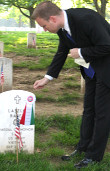 enemy
movement was detected. enemy
movement was detected.
As he and a comrade prepared to clear the area, he heard
an incoming grenade as it landed in the midst of the team's perimeter.
With complete disregard for his own life, he threw himself on the grenade
and, covering it with his body, received the complete impact of the immediate
explosion. By gallantry at the cost of his life in the highest traditions
of the military service, he has reflected great credit upon himself and
the US Army.
BURIED AT: SECTION 62, #1326
Read more on Arlington
Cemetery.net
Capt.
Ákos Dezsö Székely
(b. 3/24/1942, d. 9/11/1968)
Silver Star for Gallantry in Action
 Captain
Szekely distinguished himself by heroic actions on 11 September 1968,
while serving as Commanding Officer with Company A, 1st Battalion, 5th
Infantry near Ben Cui, Vietnam. His unit was established in its night
location when they came under intense fire from a numerically superior
enemy force. He immediately ran to the perimeter through heavy enemy fire
in order to direct his men’s suppressive fire, braving fierce. Captain
Szekely distinguished himself by heroic actions on 11 September 1968,
while serving as Commanding Officer with Company A, 1st Battalion, 5th
Infantry near Ben Cui, Vietnam. His unit was established in its night
location when they came under intense fire from a numerically superior
enemy force. He immediately ran to the perimeter through heavy enemy fire
in order to direct his men’s suppressive fire, braving fierce.
 With
complete disregard for his own personal safety, he moved about the bullet
swept area, and while engaging the enemy with his M-16 rifle, Captain
Szekely was mortally wounded. His valorous actions contributed immeasurably
to the successful completion of his mission and the defeat of the enemy
force. He appears to be the only Hungarian American whose tombstone uses
Hungarian accented characters. When competing for an appointment to West
Point, Representative John R. Foley, Sixth Maryland District, reported
his selection from the large number of finalists with this remark: “Akos
Szekely…the most unique, special, and outstanding student I ever
appointed to the United States Military Academy.” He would go on
to rank near the top in all of his academic courses and graduated number
five in his class on 3 June 1964, and has been recognized as the highest
ranking graduate of Hungarian ancestry from any of the United States Service
Academies. With
complete disregard for his own personal safety, he moved about the bullet
swept area, and while engaging the enemy with his M-16 rifle, Captain
Szekely was mortally wounded. His valorous actions contributed immeasurably
to the successful completion of his mission and the defeat of the enemy
force. He appears to be the only Hungarian American whose tombstone uses
Hungarian accented characters. When competing for an appointment to West
Point, Representative John R. Foley, Sixth Maryland District, reported
his selection from the large number of finalists with this remark: “Akos
Szekely…the most unique, special, and outstanding student I ever
appointed to the United States Military Academy.” He would go on
to rank near the top in all of his academic courses and graduated number
five in his class on 3 June 1964, and has been recognized as the highest
ranking graduate of Hungarian ancestry from any of the United States Service
Academies.
BURIED AT: SECTION 62, #1326
Also on the Vietnam Memorial, "The Wall" at
Panel 44W, Line 31
Read more about him [here]
and [here]
TEC5
Andrew Major
(b. Hungary 8/18/1921, d. 10/15/2004)
 A
preeminent textile pioneer and legend in the textile industry, fondly
known as ''The King of the Mills.'' Born in Hungary and educated in Switzerland
and England, he served in the US Army as a decorated veteran of the Pacific
Theater. Born in Hungary in 1921, educated in Switzerland and England,
served in the U.S. Army as a decorated veteran of the Pacific Theater. A
preeminent textile pioneer and legend in the textile industry, fondly
known as ''The King of the Mills.'' Born in Hungary and educated in Switzerland
and England, he served in the US Army as a decorated veteran of the Pacific
Theater. Born in Hungary in 1921, educated in Switzerland and England,
served in the U.S. Army as a decorated veteran of the Pacific Theater.
As former president of Collins and Aikman Decorative Fabrics, he presided
over the world's leading fabric group. He joined Mastercraft in 1946,
became president in 1960, assumed ownership in 1969, and is responsible
for the company's meteoric rise, which today provides employment for 3,500
and sales in excess of $350 million. The recipient of numerous industry
and civic awards, including the first Lifetime Leadership Award from Dupont
in 1995, which embodied his creativity, devotion and legendary status
in the industry. In 2002 he received ''The Trailblazer Award'' and was
inducted into the American Furniture Hall of Fame.
He will always be remembered for his wit, generosity and love of life.
In lieu of flowers the family asked for contributions to the Andrew Major
Scholarship Fund at Isothermal Community College, P.O. Box 804, 288 ICC
Loop Road, Spindale, N.C. 28160. BURIED
AT: COLUMBARIUM, SECTION 5-OO ROW 10 SITE 6
Read more about him on Arlington
Cemetery.net
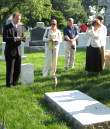 Capt.
Ödön Gurovits Capt.
Ödön Gurovits
(b. 1/21/1857, Budapest, d. 1/14/1902, Philippines)
Private, Corporal and Sergeant, Company C and Sergeant Major, 6th United
States Infantry, 16 Mar 1880 to 22 October 1886, Second Lieuetnant, 11th
United States Infantry, 22 October 1886, First Lieutenant, 12th United
States Infantry, 15 December 1893, Transferred to 11th United States Infantry,
16 April 1894, Captain, 2 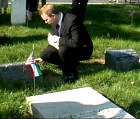 March
1899. Died in BayBay, Leyte, Philippines. His wife, Mary Brent Gurovits
(1858-1929) is buried with him. BURIED AT:
SECTION 21, #143 March
1899. Died in BayBay, Leyte, Philippines. His wife, Mary Brent Gurovits
(1858-1929) is buried with him. BURIED AT:
SECTION 21, #143
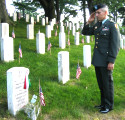 Major
Nicholas Ferencz, III Major
Nicholas Ferencz, III
(b. 1964, Cleveland, d. 9/11/2000)
US Marine Corps.
Served in Desert Storm. A weapons systems officer with 7 years service,
he and the pilot were tragically lost on September 11, 2000 as a result
of a mid-air collision between two F/A-18D Hornets near Yuma, Arizona.
Seen here is AHF's Lt. Col. Steve Vekony saluting Maj. Ferencz.
BURIED AT: SECTION MI, SITE 22
S/Sgt. George
Alexander de Holczer
(11/23/14 – 07/25/2003)
Born in the US, his parents (Louis John de Holczer and Sarolta
Anna Klára Putnoky de Holczer) and two siblings (Lászlo
and József) were born in Hungary. All became US citizens. Served
with the US Army Air Corps. During WWII. BURIED
AT: COLUMBARIUM, SECTION 6-OO ROW 21 SITE 2
Petty Officer
Paul Ivány
Served in the US Navy in 1977-1979.BURIED
AT: COLUMBARIUM, SECTION 8G ROW 24 SITE 6
Did you know there are
at least 8 Hungarian American recipients of the Congressional Medal of
Honor? Read more about Maj. General Asboth and other Hungarian
American Military Heroes on The Hungary Page's "Nobel Prize Winners
and Famous Hungarians" Military
Section.
|

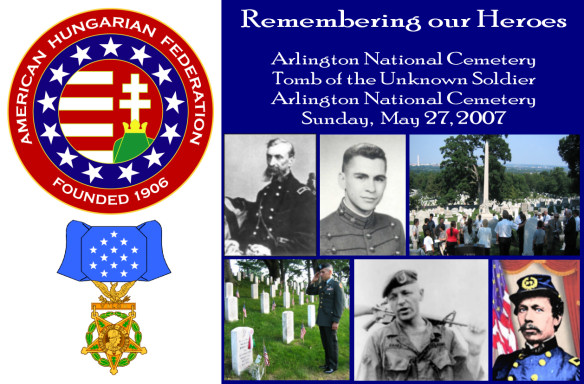





 We
met the son of Francis Gary Powers the US national hero who risked his
life and was shot down in his high-altitude spyplane over the red skies
of the Soviet Union. Francis Jr. (seen here to the left of Janet and Doug
Kozlay, Pro Cultura Hungarica plaque recipients) carries on the fight
to make sure the world remembers his father and Soviet tyranny as Founder
and President of the Cold War Museum.
We
met the son of Francis Gary Powers the US national hero who risked his
life and was shot down in his high-altitude spyplane over the red skies
of the Soviet Union. Francis Jr. (seen here to the left of Janet and Doug
Kozlay, Pro Cultura Hungarica plaque recipients) carries on the fight
to make sure the world remembers his father and Soviet tyranny as Founder
and President of the Cold War Museum.

 The
American Hungarian Federation (AHF) established the Colonel Commandant
Michael Kovats Medal of Freedom to honor outstanding individuals and recognize
their life's achievements, dedication to freedom and democracy, promotion
of transatlantic relations, and meritorious contribution to society. The
award, AHF's highest honor, is open to Hungarians and non-Hungarians alike.
The
American Hungarian Federation (AHF) established the Colonel Commandant
Michael Kovats Medal of Freedom to honor outstanding individuals and recognize
their life's achievements, dedication to freedom and democracy, promotion
of transatlantic relations, and meritorious contribution to society. The
award, AHF's highest honor, is open to Hungarians and non-Hungarians alike. On
May 11, 1779, Colonel Kovats gave his life in the American War for Independence
while leading the Continental Army cavalry he had trained in Hungarian
hussar tactics against a British siege of Charleston. The British remarked
that Kovats' forces were "the best cavalry the rebels ever had."
He is immortalized in the almost lifesize portrait by Gabriella Koszrous-Varsa
seen here. He is immortalized at the Citadel Miltary Academy in South
Carolina as they honor him and named "Kovats Field" after him.
The Hungarian Embassy, too, has a statue in his honor sculpted by Paul
Takacs and executed by Attila Dienes.
On
May 11, 1779, Colonel Kovats gave his life in the American War for Independence
while leading the Continental Army cavalry he had trained in Hungarian
hussar tactics against a British siege of Charleston. The British remarked
that Kovats' forces were "the best cavalry the rebels ever had."
He is immortalized in the almost lifesize portrait by Gabriella Koszrous-Varsa
seen here. He is immortalized at the Citadel Miltary Academy in South
Carolina as they honor him and named "Kovats Field" after him.
The Hungarian Embassy, too, has a statue in his honor sculpted by Paul
Takacs and executed by Attila Dienes. Just
as Kovats’ life and service is celebrated annually by US Military
Cadets at the Citadel, the motto reflects AHF virtues, and historically
and inextricably ties Hungarians and Americans together while symbolizing
Hungarians’ contributions and sacrifices to America’s beginning.
Among the oldest ethnic organizations in the US, AHF was founded in 1906
in Cleveland, Ohio, and established as an association of Hungarian societies,
institutions and churches to “defend the interest of Americans of
Hungarian origin in the United States.”
Just
as Kovats’ life and service is celebrated annually by US Military
Cadets at the Citadel, the motto reflects AHF virtues, and historically
and inextricably ties Hungarians and Americans together while symbolizing
Hungarians’ contributions and sacrifices to America’s beginning.
Among the oldest ethnic organizations in the US, AHF was founded in 1906
in Cleveland, Ohio, and established as an association of Hungarian societies,
institutions and churches to “defend the interest of Americans of
Hungarian origin in the United States.”  Asbóth was a General in the Hungarian Army. Following the Hungarian
democratic Revolt of 1848 against Austria, he followed Kossuth to the
United States in 1851. He offered his services to the Union when the Civil
War broke out. John C. Fremont appointed him a Brigadier General of Volunteers
and chief-of-staff. Seriously wounded three times during the war, he was
appointed to the rank of general in l864.
Asbóth was a General in the Hungarian Army. Following the Hungarian
democratic Revolt of 1848 against Austria, he followed Kossuth to the
United States in 1851. He offered his services to the Union when the Civil
War broke out. John C. Fremont appointed him a Brigadier General of Volunteers
and chief-of-staff. Seriously wounded three times during the war, he was
appointed to the rank of general in l864.

 Hussar in the 1848 war of independence. Escaped with Kossuth to the United
States. Worked as a Journalist. At the outbreak of the Civil War, organized
the 8th New York Volunteer Infantry becoming lieutenant-colonel. At the
Hussar in the 1848 war of independence. Escaped with Kossuth to the United
States. Worked as a Journalist. At the outbreak of the Civil War, organized
the 8th New York Volunteer Infantry becoming lieutenant-colonel. At the

 Fairfax
Court House, Lincoln summoned Stahel and ordered him to take charge of
the cavalry at Fairfax and raised him to the rank of major general.
Fairfax
Court House, Lincoln summoned Stahel and ordered him to take charge of
the cavalry at Fairfax and raised him to the rank of major general.
 Laszlo earned the Medal of Honor in Vietnam while serving in the 173rd
Airborne Brigade on November 13, 1968 “for conspicuous gallantry
and intrepidity in action at the risk of his own life above and beyond
the call of duty.“ He distinguished himself while serving as leader
of Team Delta, 74th Infantry Detachment. Team Delta was in a defensive
perimeter conducting reconnaissance of trail networks when
Laszlo earned the Medal of Honor in Vietnam while serving in the 173rd
Airborne Brigade on November 13, 1968 “for conspicuous gallantry
and intrepidity in action at the risk of his own life above and beyond
the call of duty.“ He distinguished himself while serving as leader
of Team Delta, 74th Infantry Detachment. Team Delta was in a defensive
perimeter conducting reconnaissance of trail networks when 
 Captain
Szekely distinguished himself by heroic actions on 11 September 1968,
while serving as Commanding Officer with Company A, 1st Battalion, 5th
Infantry near Ben Cui, Vietnam. His unit was established in its night
location when they came under intense fire from a numerically superior
enemy force. He immediately ran to the perimeter through heavy enemy fire
in order to direct his men’s suppressive fire, braving fierce.
Captain
Szekely distinguished himself by heroic actions on 11 September 1968,
while serving as Commanding Officer with Company A, 1st Battalion, 5th
Infantry near Ben Cui, Vietnam. His unit was established in its night
location when they came under intense fire from a numerically superior
enemy force. He immediately ran to the perimeter through heavy enemy fire
in order to direct his men’s suppressive fire, braving fierce.  A
preeminent textile pioneer and legend in the textile industry, fondly
known as ''The King of the Mills.'' Born in Hungary and educated in Switzerland
and England, he served in the US Army as a decorated veteran of the Pacific
Theater. Born in Hungary in 1921, educated in Switzerland and England,
served in the U.S. Army as a decorated veteran of the Pacific Theater.
A
preeminent textile pioneer and legend in the textile industry, fondly
known as ''The King of the Mills.'' Born in Hungary and educated in Switzerland
and England, he served in the US Army as a decorated veteran of the Pacific
Theater. Born in Hungary in 1921, educated in Switzerland and England,
served in the U.S. Army as a decorated veteran of the Pacific Theater.

